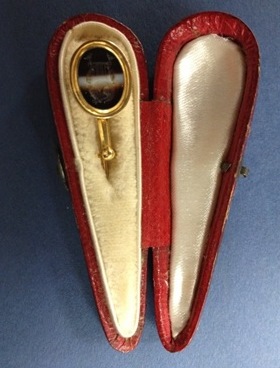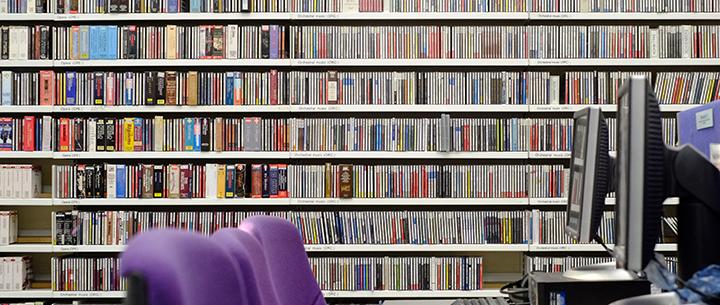Diana Wood was an E.T. Bryant prize winner in 2015 for her dissertation on The Music Collections of Cambridge University : An investigation into perceptions of the value of user-generated content in a special collections catalogue. Here are some further thoughts a year on….

Breast pin formerly owned by the composer from the Marion Scott Haydn collection in Cambridge University Library.
“I came to research and write my dissertation almost by chance. In my third (and theoretically final) year of my library degree, I attended a talk by Richard Andrewes (former Head of Music, Cambridge University Library) about the hidden musical collections in the University of Cambridge. The romantic in me was spellbound by the idea of these undiscovered treasures, lurking in boxes hidden in cupboards below the backstairs in ancient college basements, and I jealously retained the notes I made on this for two years before I actually got to the point of research. Even as a music student, I’d had no idea of the breadth and depth of these collections, and having not specialised in anything which required access to them, I’d no idea how others managed to find what was there. I was coached by my supervisor at Aberystwyth University in how to turn this initial excitement into something that could be investigated, researched and written up, which played out in how much my research seemed to change throughout the months. But ultimately I always retained this desire to say “Look! Here’s an opera about angry penguins; there’s an autograph manuscript by an alumnus of the university lurking forgotten in a library; here’s this pin which was WORN BY HAYDN HIMSELF!”
The research itself I found quite difficult, not least because being based in an art reference library I was somewhat divorced from the day-to-day enquiries that the University music libraries’ staff would field. Things that I found out purely by chance, or through what felt to me huge and painstaking effort, they would know and rattle off immediately. I came away from my interviews feeling I was learning just as much about the collections from the enthusiastic researchers and musicians using them as I was from the library staff who looked after them, and questioning my own information-seeking skills as a result. If they were finding the material they needed so easily, why was I so sure that more people needed to be aware of it? Maybe for every scholar who knew how to find what they needed, there were twenty more who didn’t. It would have been interesting to compare the information-seeking skills of the younger scholars with those of the older ones, to learn about what assumptions each had about what information should be available, where, and in what form.
What I found interesting was how discrete everything was. I already knew that the collections varied widely, but so did the needs of the people accessing them – one was researching for a biography of a composer they were writing, another using the materials for performing, another for creating a new edition of a musical work. And this was only the select few I interviewed; others use the collections for vastly different purposes, for example in studying watermarks of incunabula, or charting the development of playing technique – musical, nonmusical, scholarly, practical…each came to their part of the collections from different directions, and often sought the information in different ways.

My first IAML Annual Study Weekend helped to trigger a tangential aspect to my research, in that the Jerwood Library at Trinity Laban showed how certain problems could be worked around, if not totally overcome. Printed handlists are often the only documentation of the contents of an archive, and few libraries have the time and resources to catalogue everything fully. Trinity Laban had circumvented this by scanning their handlists and making them available online – with minimal effort, these archives went from near-invisible to accessible, though not necessarily via the most traditional path. This is one element of the research which spoke volumes to me; making things visible in any form is better than keeping them invisible simply because you don’t have the resources to do it properly. I’ve since been scanning the handlists of my library’s collection of auction catalogues to put them online until we have the resources to individually catalogue each item (the collection runs into the thousands!).
My dissertation was about using the users to make connections and trying to join everything up, but I think rather than proving that a single catalogue with user-generated content would be useful, instead I demonstrated that ‘one size fits none’! Practically speaking, each type of collection had its own challenges and limitations, which seemed to be best addressed individually, or as smaller groups, rather than by this over-arching and somewhat bombastic approach. Still, even if the answer to ‘could this be done?’ was a resounding ‘NO’, or at least a very firm ‘not yet’, I felt it was worth investigating to see what problems there were, whether or not they were insurmountable, and indeed, whether or not they were worth surmounting for the number of people they would benefit.
So in light of all this, what now? Following my research, I was delighted to be able to undertake a secondment at the departments in question, although only briefly as I then went on maternity leave before returning to work at my substantive institution. In that time I was able to gain a much deeper insight into the behind-the-scenes goings-on at both libraries, and get involved in all manner of tasks, from inductions and blogging to cataloguing of books and sheet music. I could see how well the music staff knew their collections and how to help users navigate to what they wanted, and felt privileged to be part of that, if only briefly. It has definitely helped my own information seeking and research as a result; before I would give up far too easily if the information couldn’t be found online, now I tend to be more tenacious about digging up an answer, which has improved my success rate with enquiries and makes me much more likely to take on the research myself rather than have to ask one of my colleagues with greater specialist knowledge. I’m also still very much keeping the users in the forefront of my mind – our collections are here to be used after all. At the moment I’m researching the library induction format – my plan is to experiment with new forms of library induction come Michaelmas Term when the new intake of History of Art students arrive. I can’t wait!
Diana Caulfield (nee Wood), Fitzwilliam Museum